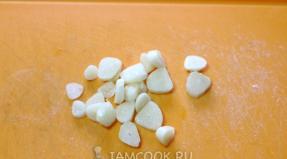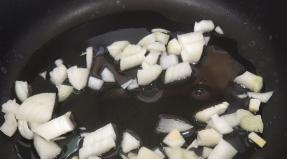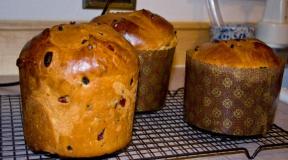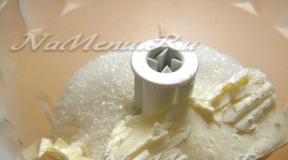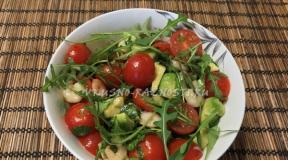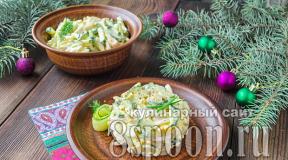Fortified milk. Acquaintance with baby milk: differences from regular milk, norms and brands Fortified milk GOST
2-04-2012, 23:20
In the human diet, vitamin C is the most deficient. Throughout the year, with the exception of July, August and September, the content of vitamin C in food is less than the norm, and in the spring months, its deficiency reaches 50%.
The content of vitamin C in milk is not very high. Due to its easy oxidizability, a significant amount of it is destroyed during the processing and transportation of milk. With these factors in mind, pasteurized milk is produced fortified with vitamin C.
Fortified milk has the same composition, organoleptic and physico-chemical parameters as pasteurized whole milk. The content of vitamin C in it should be at least 10 mg per 100 ml of milk. Taking into account losses per 1 ton of milk, 110 g of ascorbic acid are added. The original milk should have an acidity of no more than 18 °T, since the addition of ascorbic acid increases the acidity of the product.
The technological process for the production of fortified milk consists of the same operations as the production of pasteurized milk. To reduce the loss of vitamin C, it is added to milk after pasteurization. To do this, the vitamin preparation in the form of a powder, added at the rate of 110 g per 1000 liters of milk for young children and 210 g for older children and adults, is slowly poured into the tank with constant stirring, then continue to mix for another 15-20 minutes and keep in within 30-40 min. The finished product is poured and stored until it is sold at a temperature not exceeding 4 ° C, since an increase in temperature not only adversely affects the quality of milk, but also causes the destruction of vitamin C.
For young children (up to three years old), milk is produced with a complex of vitamins A, C and D2. It is prepared on the basis of milk with an acidity of not more than 18 °T and a density of at least 1028 kg / m3 with the addition of solutions of vitamin A in oil, vitamin D2 in oil and medical ascorbic acid (vitamin C). Vitamins are added to normalized milk before pasteurization. A milk-vitamin concentrate is prepared from fat-soluble vitamins A and D2, for which the required amount of solutions of vitamins A and D2 is added to milk heated to a temperature of 60-85 ° C, and it is thoroughly kneaded. The milk-vitamin concentrate is homogenized and then introduced into raw normalized milk to be fortified. Vitamin C is added to milk after pasteurization as described above.
In different countries, milk is enriched in different ways: with only one vitamin or, on the contrary, with a whole complex, and iron and iodine preparations are also added to it.
page 1

page 2

page 3

page 4

page 5

page 6

page 7

page 8

page 9

page 10

page 11

page 12
INTERSTATE COUNCIL FOR STANDARDIZATION, METROLOGY AND CERTIFICATION
INTERSTATE COUNCIL FOR STANDARDIZATION, METROLOGY AND CERTIFICATION
INTERSTATE
STANDARD
DRINKING MILK ENRICHED
General specifications
Official edition
|
Standartinform |
Foreword
The goals, basic principles and basic procedure for carrying out work on interstate standardization are established by GOST 1.0-92 “Interstate standardization system. Basic Provisions” and GOST 1.2-2009 “Interstate Standardization System. Interstate standards, rules and recommendations for interstate standardization. Rules for the development, adoption, application, updating and cancellation "
About the standard
1 DEVELOPED by the Federal State Budgetary Scientific Institution "All-Russian Scientific Research Institute of the Dairy Industry" (FGBNU "VNIMI")
2 INTRODUCED by the Federal Agency for Technical Regulation and Metrology (Rosstandart)
3 ADOPTED by the Interstate Council for Standardization, Metrology and Certification (Minutes of November 12, 2015 No. 82-P)
4 By order of the Federal Agency for Technical Regulation and Metrology dated November 30, 2015 No. 2088-st, the interstate standard GOST 33478-2015 was put into effect as the national standard of the Russian Federation from July 1, 2016.
5 INTRODUCED FOR THE FIRST TIME
Information about changes to this standard is published in the annual information index "National Standards", and the text of changes and amendments - in the monthly information index "National Standards". In case of revision (replacement) or cancellation of this standard, a corresponding notice will be published in the monthly information index "National Standards". Relevant information, notification and texts are also posted in the public information system - on the official website of the Federal Agency for Technical Regulation and Metrology on the Internet
© Standartinform, 2016
In the Russian Federation, this standard cannot be fully or partially reproduced, replicated and distributed as an official publication without the permission of the Federal Agency for Technical Regulation and Metrology
Bibliography
Technical regulation of the Customs Union TR TS 021/2011 "On food safety"
Technical regulation of the Customs Union TR TS 033/2013 "On the safety of milk and dairy products"
Technical regulation of the Customs Union TR TS 029/2012 "Safety requirements for food additives, flavors and technological aids"
Technical regulation of the Customs Union TR CU 022/2011 "Food products in terms of their labeling"
Technical regulation of the Customs Union TR TS 005/2011 "On the safety of packaging"
9
UDC 637.146.2:006.354 OKS 67.100.10 N17 OKP92 22Yu
Key words: fortified drinking milk, classification, technical requirements, indicators, characteristics, labeling, packaging, acceptance rules, control methods, transportation, storage
Editor Z.Yu. Belyakova Proofreader O.V. Lazareva Computer layout A.V. Balvanovich
Signed for publication on February 8, 2016. Format 60x84Vs.
Uel. oven l. 1.40. Circulation 51 copies. Zach. 120.
Prepared on the basis of the electronic version provided by the developer of the standard
FSUE "STANDARTINFORM"
123995 Moscow, Granatny per., 4. www.gostinfo.ru [email protected]
INTERSTATE STANDARD ENRICHED DRINKING MILK General specifications
Enriched drinking milk. General specifications
Introduction date - 2016-07-01
1 area of use
This standard applies to packaged in consumer packaging after heat treatment or heat-treated in consumer packaging fortified drinking milk (hereinafter referred to as the product) made from raw cow's milk and (or) dairy products, enriched separately or in combination with milk protein, vitamins, micro- and macronutrients, prebiotic substances (prebiotics), polyunsaturated fatty acids, phospholipids, dietary fiber, intended for direct consumption.
Requirements to ensure product safety are set out in 5.1.4 - 5.1.6, quality requirements - in 5.1.2, 5.1.3, labeling requirements - in 5.3.
2 Normative references
This standard uses normative references to the following standards:
3 Terms and definitions
This standard uses the terms and definitions established by , , .
4 Classification
4.1 The product, depending on the raw milk, is made from:
whole milk;
normalized milk;
Skimmed milk.
4.2 The product, depending on the heat treatment mode, is divided into:
Pasteurized;
Sterilized;
UHT.
4.3 The product, depending on the food and biologically active substances used, is enriched with:
milk protein;
Vitamins and their complexes (premixes);
prebiotics;
dietary fiber;
Micro and / or macro elements;
Polyunsaturated fatty acids (PUFAs);
Phospholipids.
5 Technical requirements 5.1 Main indicators and characteristics
5.1.1 The product is manufactured in accordance with the requirements of this standard according to technical documents, standards of organizations approved in the prescribed manner for a specific product name in compliance with the requirements of regulatory legal acts.
5.1.2 The organoleptic characteristics of the product must meet the requirements specified in Table 1.
|
Table 1 |
||||||||||
|
5.1.3 In terms of physical and chemical parameters, the product must comply with the standards specified in Table 2.
|
table 2 |
|||||||||||||||||||||||||||||||||||
|
|||||||||||||||||||||||||||||||||||
|
End of table 2 |
|||||||||
|
|||||||||
|
15 For product enriched with milk protein. Notes: 1 For a product made from whole milk, the mass fraction of fat is set as a range of actual values (for example, from 3.2% to 3.9%), the values of other indicators must comply with the norms of table 2. 2 Mass fractions of biologically active substances (vitamins, micro- and macroelements, dietary fiber, prebiotics, PUFAs, phospholipids, etc.) are set in technical documents or standards of organizations for a specific product name, indicating the ratio of the amount of added ingredients to the daily rate of their consumption. At the same time, the content of each food or biologically active substance used for enrichment should be brought to the level of consumption in 100 ml, or 100 g, or a single serving of the product of at least 5% of the daily intake level, and the maximum content of food and (or) biologically active substances in the product should not exceed the upper safe intake level of such substances (if such levels exist). |
5.1.4 Permissible levels of potentially hazardous substances in the product should not exceed the requirements , .
5.1.5 Permissible levels of microorganisms in the product should not exceed the requirements , .
5.1.6 The UHT product (with aseptic filling) and sterilized must comply with the requirements of industrial sterility.
5.2 Requirements for raw materials
5.2.1 For the manufacture of a pasteurized product, the following raw materials are used:
5.4 Packaging
5.4.1 Packaging materials, consumer and transport packaging used for packaging the product must comply with the requirements of the documents in accordance with which they are made, and ensure the preservation of the quality and safety of the product during its transportation, storage and sale.
5.4.2 The product is packed in consumer packaging with subsequent placement in group and/or transport packaging.
5.4.3 The limits of permissible negative deviations of the net weight of the product in one packaging unit from the nominal - according to the regulatory and technical documents in force on the territory of the states that have adopted the standard.
5.4.4 The formation of group packaging is carried out in accordance with GOST 25776.
5.4.5 Transport packages are formed according to GOST 23285 and GOST 26663.
5.4.6 The overpack is stowed in such a way that the marking of at least one unit of the group package and / or overpack is visible on each side of the overpack.
The stacking of the transport package is carried out by methods that ensure the safety of the lower rows of the group and/or transport packaging without their deformation.
5.4.7 The product shipped to the regions of the Far North and equivalent areas is packaged in accordance with GOST 15846.
6 Acceptance rules
6.2 To check the compliance of the product with the requirements of the document in accordance with which the product of a particular name is manufactured, acceptance tests (in accordance with GOST 26809.1) and periodic tests are carried out.
6.3 Acceptance tests are carried out by the method of selective control for each batch of the product for compliance with the requirements of the document for the product of a specific name: in terms of packaging quality, correct marking, net weight or volume of the product, organoleptic and physico-chemical parameters.
6.4 Periodic tests are carried out according to safety indicators (the content of pesticides, toxic elements, antibiotics, radionuclides, aflatoxin, microbiological indicators) in accordance with the production control program.
6.5 Dioxins, melamine, GMOs are determined in case of a reasonable assumption about their possible presence in food raw materials.
6.6 Upon receipt of unsatisfactory test results, at least for one of the quality indicators (deviation from the normalized value), it is re-analyzed with a double sample taken from the same batch of product.
GOST 26754 GOST 3626
7.16 Determination of the mass fraction of dietary fiber - according to the methods, regulatory documents in force on the territory of the states that have adopted the standard.
7.17 Determination of the mass fraction of lactulose - according to the methods, regulatory documents in force on the territory of the states that have adopted the standard.
7.18 Determination of the mass fraction of PUFA - according to the methods, regulatory documents in force on the territory of the states that have adopted the standard.
7.19 Determination of phospholipids - according to the methods approved in the prescribed manner.
7.20 Determination of the content of toxic elements:
8.4 The pasteurized, ultra-pasteurized product (without aseptic filling) is stored at a temperature of (4 ± 2) °C.
The sterilized and ultra-pasteurized product (with aseptic filling) is stored at a temperature of 2 °C to 25 °C.
The shelf life of the product from the end of the technological process is set by the manufacturer, taking into account the requirements of regulatory legal acts in the field of food safety.
Everyone knows that children need to drink milk. But for some reason, many are mistaken, believing that the beneficial properties of milk do not apply to the body of an adult. But this is not at all the case - adults, no less than children, need to eat milk. Who benefits from milk?
Useful properties of milk

Milk - source of calcium, 97% of which is absorbed by the human body. This feature of milk, which no other product has, makes it indispensable for people with osteoporosis- a disease in which calcium is washed out of the bones, provoking their fragility and fragility.
Is milk good with colds? Yes, definitely! The thing is that milk protein is digested more easily than other protein foods - and it is from it that the proteins necessary to fight a viral infection are formed. immunoglobulins. Besides, digestibility of milk protein made this product the most popular among those who want to build muscle.
Milk - excellent tool for. The calming effect of this product on the nervous system is due to the content of the amino acids phenylalanine and tryptophan in it. No wonder one of the most common folk recipes for the treatment of insomnia is a glass of warm milk with honey, drunk an hour before bedtime.
Useful properties of milk will come to the rescue and hypertensive patients- slight diuretic effect of milk helps to reduce pressure.
Many people wonder if drinking milk is good for people with problems with the gastrointestinal tract? Milk has the ability to lower the acidity of gastric juice, so this product is ideal. remedy for heartburn, which, as a rule, provokes increased acidity of the stomach. Useful milk and with gastritis with high acidity and gastric and duodenal ulcers. However, for better absorption of milk by gastric juice, it must be drunk slowly and in small sips - otherwise its benefits will be minimized.
Milk rich in vitamins. It contains a lot of riboflavin (vitamin B2), which contributes to a full-fledged energy metabolism in the body - namely Riboflavin has the ability to convert carbohydrates and fats into energy. Therefore, milk is especially useful for weight loss(in this case, you need to use low-fat milk), malfunctions immune and endocrine systems.
Milk helps a lot. with migraines, severe headaches. An egg-milk cocktail is especially good for migraines (a raw egg in a glass of boiling milk) - a weekly course of this “medicine” will make headaches leave you for a long time.
Milk is also useful for women's health, in particular, in the treatment of mastopathy. A decoction of dill seeds in milk (100 grams of seeds per 2 cups of milk) should be taken within 2-3 weeks - this will greatly alleviate the patient's condition, the lumps in the chest will decrease.
Milk is also excellent cosmetic product. Milk washes and compresses will help with dry and irritated skin.
Who is milk bad for?
 Milk is not a panacea for all diseases. For many people, this product, for all its usefulness contraindicated.
Milk is not a panacea for all diseases. For many people, this product, for all its usefulness contraindicated.
So, a fairly large number of people have lactase deficiency An enzyme that digests lactose (milk sugar). Thus, the body of these people (who, by the way, are not so few - only about 15% of the population of our planet) unable to fully digest milk sugar, which leads to fermentation of milk in the stomach, and begins to "rebel": the stomach grumbles and swells, diarrhea begins.
Milk also belongs to the group allergen products. Milk antigen "A" is able to cause the strongest an allergic reaction in some people up to the onset of bronchial asthma. Therefore, people prone to allergies should be attentive to the use of milk and stop taking it at the first signs of an allergy: skin itching, rash, nausea, vomiting, flatulence, and bloating. At the same time, people suffering from an allergy to milk are not at all contraindicated for equally healthy fermented milk products (kefir, yogurt, cheese, cottage cheese).
If you are suffering tendency to form phosphate stones in the kidneys- and a simple general urine test can show this - milk can only harm you, contributing to their appearance.
milk also undesirable to use for people of mature and old age(after 50 years). The thing is that this product contains myristic acid, which contributes to the accumulation of lipoproteins - substances that provoke development of atherosclerosis. Since the risk of atherosclerosis increases precisely after 50 years, this age is the mark when milk consumption should, if not be excluded, then at least reduced (no more than a glass a day).
Milk should be excluded from the diet people prone to calcification- the deposition of calcium salts in the vessels.
What is milk compatible with?
 What foods are good for milk? Scientists argue that there are no special restrictions in this matter.
What foods are good for milk? Scientists argue that there are no special restrictions in this matter.
Despite the popular belief that combining milk with salty and spicy foods will lead to severe indigestion, this has not been scientifically proven. If your body does not rebel against the combination of herring or pickled cucumbers with milk, combine them to your health! In addition, milk helps neutralize the negative effects of spicy and salty foods in the body.
Concerning milk soups And milk porridge- they are also useful not only for children, but also for adults. True, in this form, the beneficial properties of milk are reduced by about half.
Many people ask: Is tea with milk healthy?? Definitely useful! Tea promotes better absorption of milk (respectively, and all its useful substances), and milk, in turn, neutralizes the negative effects on the body of caffeine and alkaloids contained in tea. Thus, mutually excluding the negative and activating the beneficial properties of each other, tea with milk forms a rather healthy and delicious drink.
Drink milk, eat other dairy products, combine milk with other foods - and be healthy!
What is milk? Types of milk and its beneficial properties will be presented in the materials of this article. We will also tell you about which animals give this product and how it should be stored properly.
General information
Milk is a nutrient fluid that is produced by the mammary glands of mammals. Its natural purpose is to feed babies who are not yet able to digest other food.
Milk and dairy products are part of many types of ghjlernjd used by humans. Their production has become a huge industry.
Milk and dairy products
Milk is obtained through the secretion of the mammary glands of mammals. It is a white liquid (sometimes it may have a yellowish tint) with a sweetish taste.
Most often in our country they use cow's milk processed in dairies. However, in other nations, this product is often obtained as a result of milking other animals. For example, sheep, mares, camels, goats and others. So, mare's milk is ideal for making koumiss, sheep's milk is used to make cheese, and camel's milk is used for shubat.
Composition
What are the components of milk? There are different types of milk. As a result, their composition also changes. It also depends on the breeds of animals, the stage of its lactation, the time of year, and so on.
According to experts, this product includes complex proteins that contain all the essential amino acids.
The mammary gland of an animal consists of many cells penetrated by lymphatic, blood and nerve vessels. It is they who deliver all the necessary substances for the synthesis of milk.
It should also be noted that this product contains fats and carbohydrates in the form of monosaccharides and lactose. The splitting of the latter in the intestine occurs rather slowly. Due to this, the fermentation of this product is restrained.
The fat content of milk is determined by the amount of fat it contains. They are in a state of emulsion and are a complex mixture of triglycerides that contain fat-soluble vitamins and lecithin.
It should also be noted that the fat content of milk determines its calorie content. Although experts say that even the most fatty product does not contain more than 60 kcal per 100 ml.

What is milk? Types of milk
The most commonly used food is pasteurized milk. It is divided into several types:
- Whole. This is which contains a certain amount of fat (that is, 2.5% or 3.2%).
- Refurbished. Such milk is partially or completely prepared from canned milk, which is cleaned, pasteurized, homogenized, cooled, bottled, etc. This product is often obtained by dissolving whole milk powder in warm water and aging it for four hours. It is during this time that the proteins are able to swell, the watery taste disappears, and normal density and viscosity are formed.
- Ghee. It's no secret that the color has a nice creamy tint. This is due to the fact that its fat content is at least 6%. It undergoes pasteurization and homogenization at a temperature of about 95 degrees with exposure for four hours. By the way, it is this processing of the product that makes the color of baked milk creamy, and also gives it a special taste and aroma.
- High fat milk. This is a normalized product that is subjected to homogenization. As a rule, it has a fat content of 6%.
- Protein. It's not just milk. In the process of normalization, condensed or dried milk is added to it. Such a product is characterized by a high content of fat-free components.
- Vitaminized. This is a very tasty and healthy milk. It is made from lean or whole food and is fortified with vitamins C, A and D.
- Non-greasy. The quality of low-fat milk always leaves much to be desired. Such a product is obtained from a pasteurized beverage by separating it. Usually its fat content is 0.05%.
Now you know what milk is. The types of milk have been listed above.
According to some nutritionists, such a sterilized product can be harmful. This is due to the fact that during such processing, calcium and milk protein are denatured and cause further health problems.
Processing in factories
The harm of milk lies in the fact that it can negatively affect the state of the human digestive system. However, this only happens if the product has been spoiled.
To increase the shelf life of the drink in question, fresh milk is first filtered and cooled, and then sent to factories. There it is cleaned, pasteurized, normalized, homogenized, and also cooled and packaged.
Due to this processing, this drink retains all the beneficial qualities. Moreover, the growth and development of microorganisms trapped in it is prevented.
Camels, cows, goats, mares, etc. do not produce milk, but are obtained by milking animals. However, in the future it is subjected to special processing. This drink is cleaned in centrifugal milk cleaners and also filtered under high pressure. As a result, all impurities are removed from the product.

To rid the milk of bacterial cells, special centrifuges are used. As you know, such a purification process is called baktefuning.
Types of processing
Just milk can not get on the shelves of stores. In industrial conditions, it must be subjected to some kind of processing.
Normalization of milk is an increase or decrease in the content of fat droplets in it. They do this to bring the mentioned indicator to the norm.
The fat content of a store-bought product should not exceed 3.2%. To do this, it is processed using a separator-normalizer or mixed with whole milk.
Pasteurization of the drink in question is carried out to increase its shelf life. To do this, normalized milk is subjected to heat treatment at a temperature of not more than 85 degrees with an exposure of 15-20 seconds.
Pasteurization can be short-term, instant and long-term. For all these types of processing use different equipment.
According to experts, instant pasteurization is carried out without exposure for several seconds. In this case, the heating temperature reaches 85-90 degrees.
With short-term pasteurization, the drink is heated to 75 degrees and kept for about 17 seconds.
Long-term pasteurization is carried out at a temperature of 65 degrees with an exposure of half an hour.
Most often, at factories, milk, the price of which is indicated below, is subjected to short-term pasteurization.
Homogenization
Another type of milk processing is homogenization. This method is necessary for the further manufacture of fermented milk products.

What is homogenization? This is the mechanical crushing of fat droplets into small particles. Such processing of the drink is carried out in order to obtain an emulsion that does not delaminate during storage.
After homogenization, the product is quickly cooled to 4-6 degrees and sent for bottling.
Fermented milk products are obtained only from pasteurized milk. As a rule, this happens in two different ways - reservoir and thermostatic.
With the reservoir method, a ready-made product is poured into containers, which has been previously aged for maturation and fermentation in special containers.
With the thermostatic method, the homogenized drink is poured into containers and fermented in thermostats, and then cooled to a temperature of 8 degrees.
Storage
Usually milk is stored at a temperature of 2-5 degrees for about 2-3 days. With its industrial processing, this period can be increased several times. If milk is packaged in special bags or bottles, then its shelf life often reaches several months. However, the usefulness of such a product is highly questionable.
To significantly increase the shelf life of the drink in question, it is thickened with sugar or dried.
Why shouldn't you drink milk?
The harm of milk lies in the fact that with its prolonged use, a person begins to experience severe weakness. According to some experts, lovers of this product quickly accumulate fat and accelerate the aging process.
It should also be noted that the use of such products can cause osteoporosis, allergies, indigestion, flatulence and blockage of the artery. That is why many nutritionists recommend eliminating milk, butter, and cream from your diet. As for low-fat yogurt and cheeses, you can afford them, but only in limited quantities.
The benefits of the product and its price
How much does milk cost? Its price depends on the type and method of processing. As a rule, the cost of one liter of such a drink varies between 30-65 rubles.
The health benefits of milk have been debated for a long time. Some experts argue that this is a harmful product. However, most of them are of the opinion that this drink is very useful for normalizing cholesterol metabolism. It also has a beneficial effect on the digestive system.
The positive effect of this product on the human body is due to the content of a large amount of water in it, as well as the presence of methionine, which is involved in the formation of hemoglobin.
It should also be noted that in the course of research, scientists have found that animal milk helps to stimulate the kidneys. In addition, they are the best means designed to normalize the intestinal flora. Their regular intake prevents putrefactive processes and restores the digestive system.
According to experts, the use of milk in food contributes to the protection of the body. It reduces the sensitivity of cells to the hormone insulin. In addition, people who consume butter, milk, cheeses and yogurts every day are much less likely to have high cholesterol and high blood pressure.
Dairy diet reduces the risk of obesity syndrome and insulin resistance, which very often provoke the development of diabetes and cardiovascular disease.
According to some scientists, potassium, calcium and magnesium contained in dairy products in large quantities reduce the risk of hypertension. Moreover, thanks to this drink, the development of a heart attack, diabetes and stroke can be excluded.
The invention relates to the food industry, in particular to the dairy industry. The calcium-fortified milk or dairy product includes an enriching amount of a nonionic calcium source and a food grade polyphosphate having at least six phosphate groups. The nonionic source of calcium is calcium hydrolyzed pectin, calcium citrem, lactate citrate calcium complex, or a balanced mixture of calcium lactate and calcium carbonate. Also presented is a method for preparing calcium-fortified milk or a dairy product and a variant thereof. EFFECT: invention makes it possible to prevent coagulation of milk proteins, gelation during storage of milk for 2 months and precipitation of calcium when it is added to the product. And also to get a product without bitterness or an unusual aftertaste. 3 n. and 13 z.p. f-ly, 1 tab.
The field of technology to which the invention belongs
The present invention relates to the field of the food industry and, in particular, calcium-enriched foods, and more specifically relates to shelf-stable milk enriched with calcium.
State of the art
Calcium is an essential element in human nutrition, necessary for maintaining normal bones and also for supporting other metabolic functions of the body, such as, for example, nerve impulse transmission, blood clotting, cell function and muscle contraction. Conventional methods for fortifying food products with calcium involve the use of calcium sources that are either insoluble or soluble at near neutral pH.
Many of the calcium sources for food fortification, being insoluble or substantially insoluble at near neutral pH, such as calcium carbonate, calcium phosphates, calcium citrate, and other calcium salts of organic or inorganic acids, result in precipitation resulting in a calcareous off-flavour. Other sources of calcium that are soluble or substantially soluble at near neutral pH, such as calcium chloride, calcium hydroxide, and calcium salts of certain organic acids, interact with milk proteins, causing them to undesirably coagulate and gel.
A common way to stabilize or reduce the sedimentation of calcium and milk proteins in milk drinks in which sources of calcium are introduced is the addition of guar gum, pectins and/or other substances that give the milk an unusually high viscosity. Destabilization of proteins, such as gelling, coagulation and precipitation, is mainly explained by the presence of free calcium ions in the system.
It is therefore highly desirable to have a source of calcium for fortifying beverages containing milk, casein or whey or other dairy products that does not cause coagulation, gelation and precipitation. It is also important that these calcium-fortified foods have good palatability, without bitterness or off-flavours. Adding calcium to liquid foods, especially milk and milk-based drinks, is very difficult. First, highly soluble sources of calcium (calcium chloride, etc.) interact with milk proteins, which leads to their coagulation during processing, even at pasteurization temperature. Secondly, although insoluble sources of calcium will not destabilize the micellar structure of proteins, they themselves will quickly precipitate. Third, the addition of calcium can change the balance between free and colloidal calcium in milk, leading to the formation of cross-links in proteins, which can create problems due to gelation.
The main problem with long shelf life milk is gelling over time. Despite a number of detailed studies of this defect, there is still no general theory of the mechanism of gelation during storage. According to some data, proteolysis caused by native and/or bacterial heat-resistant proteases is the cause of gelation during storage, other studies point to a mechanism involving purely physico-chemical interactions or a combination of enzymatic and physico-chemical processes. Studies on the prevention of gelation during storage of milk or dairy products fortified with calcium were not found in the literature.
AU 88768 82 describes a stabilized dairy product comprising UHT sterilized milk and a stabilizing amount of a polyphosphate or mixture of polyphosphates and/or a calcium ionic compound.
GB 446529 describes a dairy product containing sodium hexametaphosphate and an added calcium salt to improve the digestibility of the dairy product.
EP-A-0 875 153 describes a fortified food product, for example milk, containing an enriching amount of a balanced mixture of calcium lactate and calcium carbonate stabilized with glucuronic acid.
Applicants' co-pending application U.S.S.N 09/113401 (WO 00/02462) claims a fortified food product containing an enriching amount of a balanced mixture of calcium lactate and calcium carbonate stabilized with a source of glucuronic acid.
This calcium fortified milk can withstand heat treatment such as pasteurization, UHT pasteurization, UHT sterilization (UHT ultra-high temperature treatment), autoclaving, and be stored under refrigeration without coagulation and precipitation for 2 months. This calcium-fortified milk does not show any bitterness or off-taste. However, gelation on storage was noticeable after 2-2.5 months at room temperature.
Therefore, it is highly desirable to develop calcium-fortified milk and shelf-stable dairy products that do not gel during storage and preferably have improved palatability.
The essence of the invention
Applicants have found that the use of food grade polyphosphates having at least 6 phosphate groups, such as sodium hexametaphosphate (NaHMP) in calcium-fortified milk and dairy products, prevents gelation in UHT-treated milk when stored for up to 6 months at room temperature.
In accordance with the present invention, calcium-fortified milk and dairy products are provided, comprising an enriching amount of a non-ionic source of calcium and a food grade polyphosphate having at least six phosphate groups.
As a source of calcium, for example, calcium hydrolysed pectin, calcium - a negatively charged emulsifier (for example, citreme mono- and diglyceride esters of citric acid), a metastable complex of lactate and calcium citrate, or a balanced mixture of calcium lactate and calcium carbonate can be used.
Pectin and zitreme are additives commonly used in the food industry, pectin as a thickener and zitreme as an emulsifier. Pectin, which occurs naturally in fruits such as apples and naturally contains calcium, can be hydrolyzed by standard methods. Zitreme means citrate esters of mono- and diglycerides esterified with food acids. The sodium, potassium and calcium salts of these compounds can also be used.
A metastable complex of lactate and calcium citrate is obtained by reacting a slurry of an alkaline source of calcium, such as calcium hydroxide, calcium oxide, or calcium carbonate, with a solution of lactic and citric acids. The preparation of this complex is described in detail in WO 00/64267.
A balanced mixture of calcium lactate and calcium carbonate is a mixture of these two salts in such a ratio that most of the calcium is insoluble (non-ionic) calcium carbonate.
The amount of the mixture of calcium salts in the fortified food product may be from 0.1% to 5%, preferably from 0.2 to 1.0% by weight, based on the weight of the food product.
Where a balanced mixture of calcium lactate and calcium carbonate is used, a source of glucuronic acid is also included in the fortified food product. When using a balanced mixture of calcium lactate and calcium carbonate, the weight ratio of calcium lactate and calcium carbonate can be from 1:2 to 3:1, preferably from 1:1.7 to 1:1.9.
A food grade polyphosphate having at least six phosphate groups may be, for example, an ammonium or alkali metal polyphosphate, which may be a cyclic polyphosphate, preferably sodium or potassium polyphosphate. Particularly preferred is sodium hexametaphosphate.
The amount of food grade polyphosphate having at least six phosphate groups present in the fortified food product should be sufficient to inhibit gelation during storage and may be from 0.05 to 0.3%, preferably from 0.1 to 0, 2% or more preferably 0.12 to 0.15% by weight based on the weight of the food product.
The milk-based food product may be a milk drink, such as chocolate milk, or other beverages, such as juices. If desired, other minerals or vitamins may be included in such food product.
As a source of glucuronic acid, ghatti gum or gum arabic can be used. The amount of gum arabic included in the fortified product may be from 0.05 to 2.5%, preferably from 0.1 to 1.0% and more preferably from 0.2 to 0.5% by weight based on the weight of the food product. Without wishing to be bound by any theory, Applicants believe that the glucuronic acid residues in gum arabic help suspend calcium by ionic bonding without significantly increasing viscosity.
Advantageously, carrageenan is present, which may be in the lambda or iota form, but kappa carrageenan is preferred. The amount of carrageenan included in the fortified product may be from 0.005 to 0.1%, preferably from 0.01 to 0.05%, more preferably from 0.01 to 0.03% by weight of the food product.
The ingredients can be added to the milk base individually or as a mixture. The milk can then be subjected to UHT treatment without any pre-treatment (eg solids content adjustment) and pre-heat treatment.
Fortified foods containing an enriching amount of a balanced mixture of calcium lactate and calcium carbonate along with a source of glucuronic acid can be prepared by mixing a balanced mixture of calcium lactate and calcium carbonate with a food grade polyphosphate having at least six phosphate groups, adding a source of glucuronic acid acid and adding the resulting mixture to food products.
A balanced mixture of calcium lactate, calcium carbonate and a source of glucuronic acid can be added in the form of both aqueous suspensions and dry powders.
To adjust the pH of calcium-fortified milk, it is preferable to add an alkaline agent. Practically, any food grade alkalizing agent can be used for neutralization, including but not limited to: sodium hydroxide, potassium hydroxide, ammonium hydroxide, magnesium hydroxide, sodium carbonate, sodium bicarbonate, potassium carbonate, and potassium bicarbonate.
Advantageously, carrageenan can be used when added to a food product, preferably before a balanced mixture of calcium lactate and calcium carbonate (or calcium-hydrolyzed pectin or calcium-citreme or metastable lactate-citrate calcium complex) is added along with food grade polyphosphate. with at least six phosphate groups. Carrageenan can also be added to the food product either in the form of an aqueous suspension or in dry form.
If desired, a balanced mixture of calcium lactate, calcium carbonate, a source of glucuronic acid and optionally carrageenan, and a food grade polyphosphate with at least six phosphate groups can be mixed together and added as a powder.
In testing UHT-sterilized calcium-fortified skimmed milk aseptically filled into 133 ml glass bottles, Applicants found that the addition of a food grade polyphosphate with at least six phosphate groups prevented gelation when stored for 6 months at room temperature. temperature. The evaluation results of calcium-fortified skim milk (with and without addition of sodium hexametaphosphate) when stored at room temperature are shown in the following table:
| Tab. | |||||||||||||
| Composition of calcium-fortified milk | Storage time (months) | Storage time (months) | Storage time (months) | ||||||||||
| 1 | 2 | 4 | 5 | 6 | 1 | 2 | 4 | 5 | 6 | 4 | 5 | 6 | |
| Brookfield Viscosity (cP) | Visible gelation | Sediment (dry weight) | |||||||||||
| Without NaHMP | 11,3 | 16,5 | 32,5 | 52,5 | 99,1 | 1 | 7 | 10 | 10 | 10 | 0,09 | 1,39 | 5,61 |
| With NaHMP (0.075%) | 3,7 | 5,0 | 4,5 | 4,5 | 5,3 | 0 | 0 | 0 | 0 | 0 | 0,050 | 0,050 | 0,050 |
| With NaHMP (0.150%) | 5,0 | 4,5 | 6,5 | 5,4 | 5,3 | 0 | 0 | 0 | 0 | 0 | 0,040 | 0,020 | 0,02 0 |
| * The weight of the precipitate was determined from the results of sedimentation after centrifugation at 1800 g for 5 min and drying the resulting precipitate at room temperature overnight. | |||||||||||||
| ** Visually noticeable gel formation was evaluated on a scale from 0 to 10 points, according to which 0 corresponded to the absence of gel, and 10 - stable gel in the entire volume. |
Thus, calcium-fortified milk during storage showed neither gel formation nor a significant increase in viscosity with the addition of sodium hexametaphosphate (NaHMP) compared to fortified milk without NaHMP.
Further, no protein coagulation, salt precipitation, or off-flavours were also detected. Similar results were obtained for calcium-fortified 2% (fat) milk, filled into 250 ml sterile Tetra Brik ® (Tetra Pak Inc., Chicago) packages with the addition of hexametaphosphate. It was found that calcium-fortified milk to which hexametaphosphate was added was stable, no gelation was detected after 6 months of storage at room temperature, while samples without hexametaphosphate formed a gel already after 2-2.5 months when stored at room temperature.
Information confirming the possibility of carrying out the invention
Calcium-enriched skim milk (Ca content: 50% more than regular skim milk).
12.0 g of kappa carrageenan and 200 g of gum arabic are slowly added to 10 kg of skimmed milk in the liquefaction device with stirring, and mixed for 5 minutes at high speed.
Then 70 kg of skimmed milk is added to the thinner with stirring.
61.6 g of calcium lactate pentahydrate, 100.0 g of micronized calcium carbonate and 122.0 g of sodium hexametaphosphate are added with stirring to the milk with carrageenan and gum arabic, then the speed is slowly reduced. After 10 minutes of stirring, the pH of calcium-fortified milk is adjusted with 10% sodium hydroxide solution to 6.8-6.9.
The milk is preheated to 175°F, ultra high temperature (UHT) treated at 298°F for 5 seconds by steam injection, flash cooled to 175°F and homogenized at 175°F and 2500/500 psi. The milk is then cooled to 40°F, sterile filled into 133 ml glass bottles and stored for 6 months at room temperature.
After 6 months, the product is evaluated by a qualification panel of 5 experts, who found that the milk remained stable, without gelling, without precipitation, coagulation and with good taste.
1. A calcium-fortified milk or dairy product comprising an enriching amount of a nonionic calcium source and a food grade polyphosphate having at least six phosphate groups.
2. Calcium-fortified milk or milk product according to claim 1, characterized in that the non-ionic source of calcium is calcium hydrolyzed pectin, calcium-citrem, lactate-citrate calcium complex, or a balanced mixture of calcium lactate and calcium carbonate.
3. Calcium-fortified milk or milk product according to claim 1, characterized in that the content of the calcium source is 0.1-5% by weight based on the weight of the product.
4. Calcium-fortified milk or milk product according to claim 2, characterized in that, when used as a non-ionic source of calcium, a balanced mixture of calcium lactate and calcium carbonate additionally includes a source of glucuronic acid.
5. Calcium-enriched milk or milk product according to claim 2, characterized in that when a balanced mixture of calcium lactate and calcium carbonate is used as a non-ionic source of calcium, the weight ratio of calcium lactate and calcium carbonate is 1:2-3:1.
6. Calcium-enriched milk or dairy product according to claim 1, characterized in that the content of food grade polyphosphate having at least six phosphate groups in the fortified product is 0.05-0.3% by weight based on weight product.
7. The calcium-fortified milk or milk product of claim 1, wherein the food grade polyphosphate having at least six phosphate groups is sodium hexametaphosphate.
8. Calcium-enriched milk or milk product according to claim 4, characterized in that gum arabic is the source of glucuronic acid.
Read also...
- Cake "Smetannik" with custard: the easiest homemade inexpensive recipe Cake with sour cream with poppy nuts recipe
- Preservation of cucumbers for the winter - classic cooking recipes How to preserve cucumbers
- How to cook a honey ginger cake according to the classic step-by-step recipe Recipe for ginger honey cake at home
- Salads from canned fish, tasty and fast
